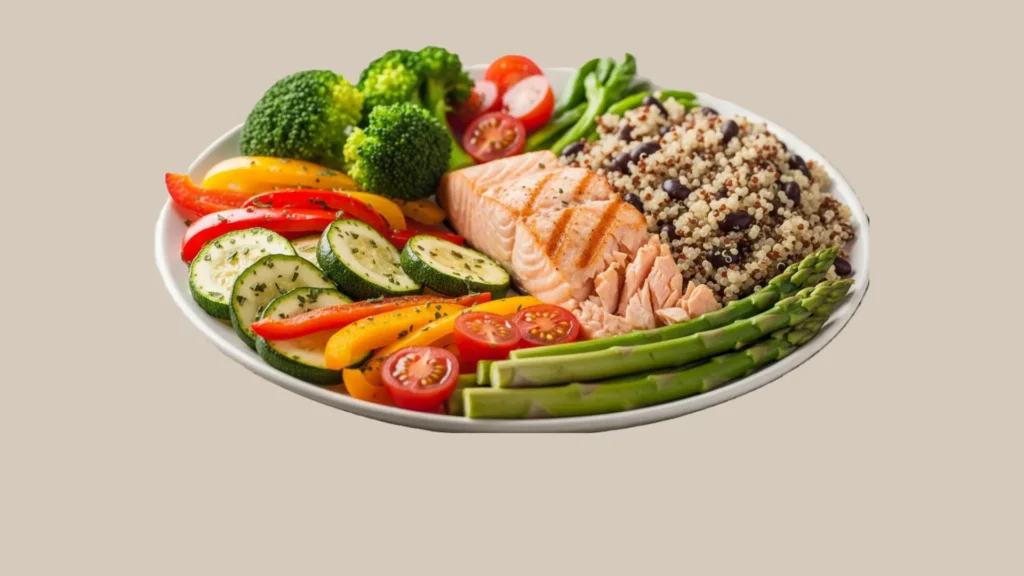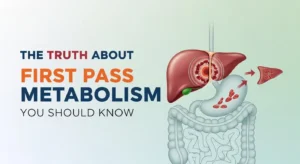Are you tired of complicated diet plans that promise quick results but leave you feeling deprived and confused? What if I told you that sustainable weight loss isn't about extreme restrictions or fad diets, but rather about creating a balanced diet that nourishes your body while helping you shed those stubborn pounds?

In this comprehensive guide, I'll show you exactly how to create a balanced diet for weight loss that's not only effective but also enjoyable and sustainable for the long term.
Why a Balanced Diet is the Key to Sustainable Weight Loss
Let's get one thing straight: crash diets might give you quick results, but they almost always lead to rebound weight gain. The real secret to lasting weight loss lies in adopting a balanced approach to eating that you can maintain for life. According to research from the National Institutes of Health, diets focusing on energy density (more food volume for fewer calories) lead to greater weight loss success and better long-term maintenance.
What Exactly is a Balanced Diet for Weight Loss?
A balanced diet for weight loss isn't about eliminating entire food groups or counting every single calorie. Instead, it's about making smart choices that create a healthy eating pattern where:
- You consume appropriate portions of nutrient-dense foods
- You get all essential nutrients your body needs
- You create a sustainable calorie deficit without feeling deprived
- You enjoy your meals and look forward to eating
The NHS Better Health initiative emphasizes that “the amount you eat is just as important as what you eat – no matter how healthy your diet is, you can still put on weight if you are eating too much.” This is why balance is crucial.
The Science Behind Balanced Eating and Weight Loss
Understanding Energy Density
One of the most powerful concepts in weight management is energy density – the number of calories in a specific amount of food. As explained by Mayo Clinic experts, “High energy density means that there are a lot of calories in a small amount of food. Low energy density means there are few calories in a large amount of food.”
Here's a striking example:
- A small order of french fries: 250 calories
- For the same calories: 10 cups of spinach, 1½ cups of strawberries, and a small apple
By focusing on low-energy-dense foods, you can eat satisfying portions while consuming fewer calories – the perfect recipe for weight loss without hunger.
The Three Factors That Determine Energy Density
- Water Content: Foods high in water (like fruits and vegetables) provide volume without calories. Grapefruit is 90% water – half a grapefruit has just 64 calories.
- Fiber Content: High-fiber foods provide volume and take longer to digest, keeping you full longer. One cup of air-popped popcorn has only about 30 calories.
- Fat Content: Fat is high in energy density. One pat of butter contains almost the same calories as 2 cups of raw broccoli.
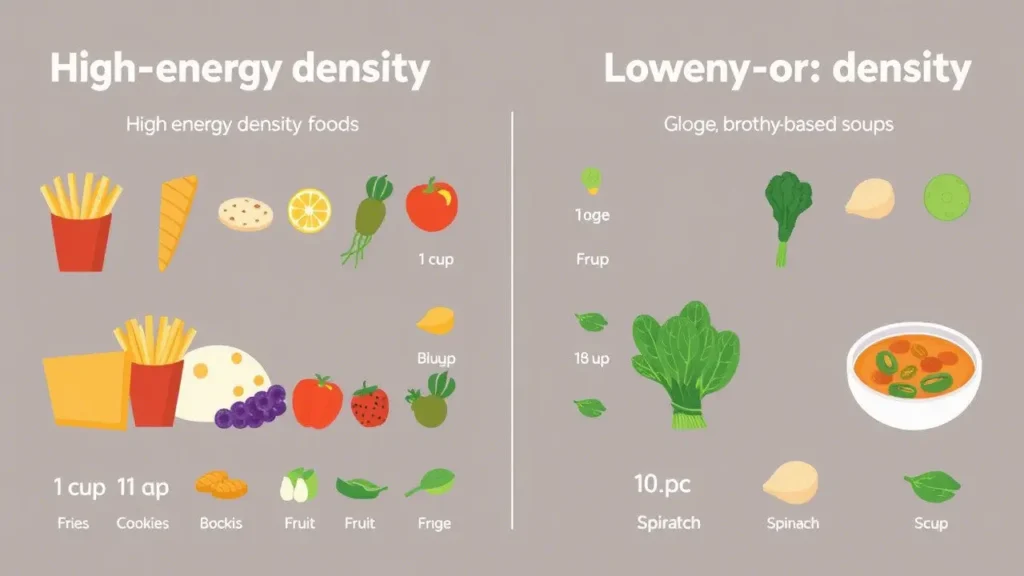
Building Your Balanced Plate: The 50/25/25 Rule
Forget complicated calorie counting. The simplest way to create balanced meals for weight loss is by using the plate method recommended by nutrition experts worldwide:
- 50% of your plate: Non-starchy vegetables
- Fill half your plate with colorful vegetables like broccoli, spinach, peppers, zucchini, and carrots
- These are low in calories but high in fiber, vitamins, and minerals
- They provide volume and help you feel full without excess calories
- 25% of your plate: Lean protein
- Include high-quality protein sources like:
- Chicken breast
- Turkey
- Fish (especially fatty fish like salmon 2x/week)
- Eggs
- Beans and lentils
- Tofu
- Protein helps maintain muscle mass during weight loss and keeps you feeling satisfied
- Include high-quality protein sources like:
- 25% of your plate: Whole grains or starchy vegetables
- Choose complex carbohydrates that provide sustained energy:
- Brown rice
- Quinoa
- Sweet potatoes
- Whole-wheat pasta
- Oats
- These provide essential fiber and nutrients while keeping blood sugar stable
- Choose complex carbohydrates that provide sustained energy:
This simple visual guide eliminates the need for measuring cups or calorie counting for most meals.
The Top 10 Foods for a Balanced Weight Loss Diet
1. Leafy Greens
Spinach, kale, Swiss chard, and other leafy greens are nutritional powerhouses that are extremely low in calories but high in volume. One cup of raw spinach has only 7 calories but provides significant amounts of vitamins A, C, and K. Add them to smoothies, soups, or as the base for salads.
2. Cruciferous Vegetables
Broccoli, cauliflower, Brussels sprouts, and cabbage are high in fiber and water content, making them perfect for weight loss. They also contain compounds that support detoxification and may help reduce belly fat.
3. Lean Proteins
Choose proteins that are high in nutrients but lower in saturated fat:
- Skinless chicken breast (108 calories per 3 oz)
- Turkey breast (114 calories per 3 oz)
- Salmon (175 calories per 3 oz, plus omega-3s)
- Eggs (78 calories per large egg)
- Lentils (18g protein per cup cooked)
4. Whole Grains
Unlike refined grains, whole grains retain their fiber-rich bran and nutrient-packed germ. Opt for:
- Quinoa (8g protein per cup cooked)
- Brown rice
- Oats
- Barley
- Whole-wheat bread (look for “100% whole wheat” as the first ingredient)
5. Berries
Strawberries, blueberries, raspberries, and blackberries are lower in sugar than many other fruits while being packed with antioxidants and fiber. One cup of strawberries has just 50 calories and 3g of fiber.
6. Healthy Fats
Don't fear fats – just choose the right ones:
- Avocado (½ medium has 120 calories)
- Nuts and seeds (small portions – 1 oz has 160-200 calories)
- Olive oil (use in moderation)
- Fatty fish like salmon
7. Legumes
Beans, lentils, and chickpeas are excellent sources of plant-based protein and fiber. One cup of cooked lentils provides 18g protein and 15g fiber for about 230 calories.
8. Greek Yogurt
Plain, non-fat Greek yogurt has double the protein of regular yogurt (about 17g per 6oz serving) with less sugar. It's versatile for both sweet and savory dishes.
9. Eggs
Despite past concerns, eggs are now recognized as a nutrient-dense superfood. They're high in protein and contain choline, which supports metabolism.
10. Water-Rich Fruits
Watermelon, cantaloupe, oranges, and grapefruit provide hydration along with nutrients and fiber, making them satisfying yet low-calorie choices.
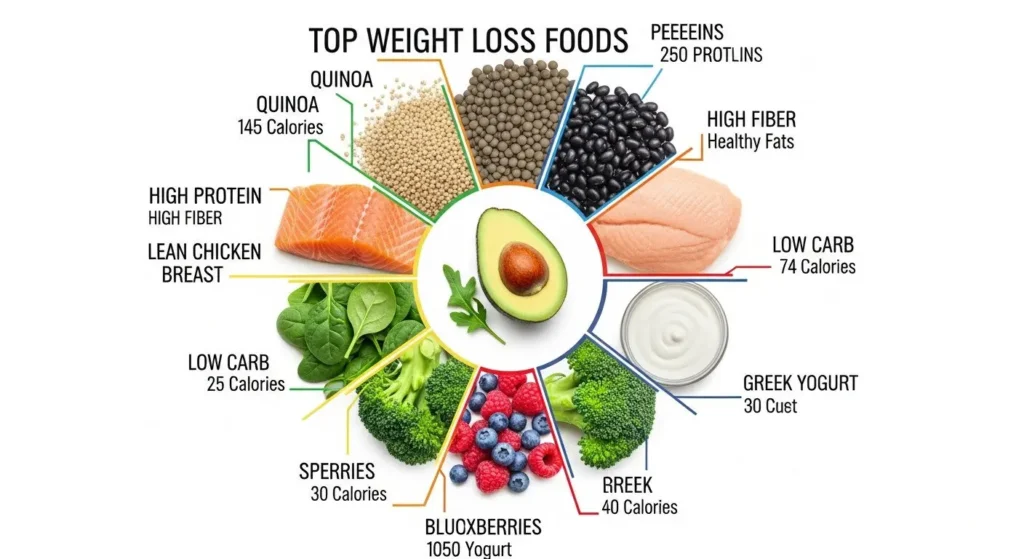
Portion Control: The Secret Weapon Many Dieters Miss
Even when eating healthy foods, portion sizes matter. The NHS recommends that carbs like potatoes, bread, rice, or pasta should make up no more than a third of your meal. Here are practical portion control strategies:
The Hand Method
- Protein: Size of your palm
- Carbs: Size of your clenched fist
- Fats: Size of your thumb
- Vegetables: Two cupped hands
Smart Swaps for Larger Portions
- Use smaller plates (9-10 inches instead of 12+ inches)
- Serve food on plates rather than eating from packages
- Pre-portion snacks into containers
- Drink a glass of water before meals to help control hunger
Mindful Eating Practices
- Eat slowly (it takes 20 minutes for fullness signals to reach your brain)
- Turn off distractions like TV while eating
- Chew thoroughly
- Stop eating when you're 80% full
Creating Your Balanced Diet Plan: A Step-by-Step Guide
Step 1: Calculate Your Calorie Needs
The average recommendation for weight loss is:
- Women: 1,400 calories per day
- Men: 1,900 calories per day
However, your specific needs depend on age, height, current weight, and activity level. Use an online calculator to determine your personalized target.
Step 2: Plan Your Meals Around the Plate Method
Structure each meal using the 50/25/25 rule we discussed earlier. For example:
Breakfast:
- 50%: Spinach and tomatoes sautéed in olive oil
- 25%: Two scrambled eggs
- 25%: ½ cup cooked quinoa
Lunch:
- 50%: Mixed greens with cucumbers, bell peppers, and carrots
- 25%: Grilled chicken breast
- 25%: ½ cup cooked brown rice
Dinner:
- 50%: Roasted broccoli and zucchini
- 25%: Baked salmon
- 25%: ½ cup cooked quinoa
Step 3: Incorporate Smart Snacking
Choose snacks that combine protein and fiber to keep you full between meals:
- Apple slices with 1 tbsp almond butter
- Carrot sticks with hummus
- Greek yogurt with berries
- A small handful of almonds (about 15)
Step 4: Stay Hydrated
The NHS recommends drinking 6-8 cups of fluid daily. Water, herbal teas, and broth-based soups count toward this goal. Sometimes thirst is mistaken for hunger, so drink a glass of water before reaching for a snack.
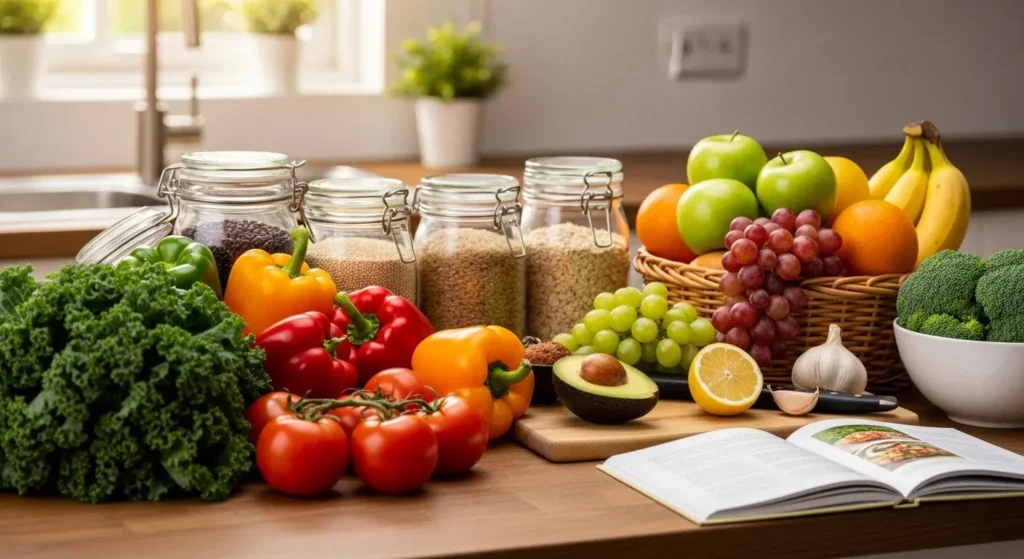
Sample 7-Day Balanced Diet Meal Plan
Day 1
- Breakfast: Overnight oats with chia seeds, berries, and a sprinkle of almonds
- Lunch: Large mixed green salad with grilled chicken, cherry tomatoes, cucumber, and balsamic vinaigrette
- Dinner: Baked salmon with roasted asparagus and quinoa
- Snack: Greek yogurt with sliced banana
Day 2
- Breakfast: Veggie omelet with spinach, mushrooms, and tomatoes
- Lunch: Lentil soup with a side salad
- Dinner: Turkey chili with mixed vegetables and a small serving of brown rice
- Snack: Apple with 1 tbsp peanut butter
Day 3
- Breakfast: Smoothie with spinach, banana, berries, and protein powder
- Lunch: Quinoa salad with black beans, corn, bell peppers, and avocado
- Dinner: Grilled chicken breast with roasted Brussels sprouts and sweet potato
- Snack: Carrot sticks with hummus
Day 4
- Breakfast: Whole-grain toast with avocado and a poached egg
- Lunch: Leftover grilled chicken and vegetable stir-fry
- Dinner: Shrimp tacos with cabbage slaw and black beans
- Snack: Cottage cheese with pineapple
Day 5
- Breakfast: Greek yogurt parfait with granola and mixed berries
- Lunch: Large mixed green salad with chickpeas, cucumbers, and olive oil dressing
- Dinner: Baked cod with roasted zucchini and brown rice
- Snack: Handful of almonds and an orange
Day 6
- Breakfast: Vegetable frittata with bell peppers and onions
- Lunch: Leftover cod and vegetable bowl
- Dinner: Turkey meatballs with tomato sauce, served over zucchini noodles
- Snack: Sliced bell peppers with guacamole
Day 7
- Breakfast: Whole-grain pancakes topped with berries and a dollop of Greek yogurt
- Lunch: Large mixed green salad with grilled shrimp, avocado, and citrus dressing
- Dinner: Stuffed bell peppers with lean ground turkey, quinoa, and vegetables
- Snack: Cottage cheese with sliced peaches
The Best Diet to Lose Belly Fat: What Really Works
Many people specifically want to know about the best diet to lose belly fat. While spot reduction isn't possible, certain dietary approaches can help reduce overall body fat, including dangerous visceral fat around your midsection.
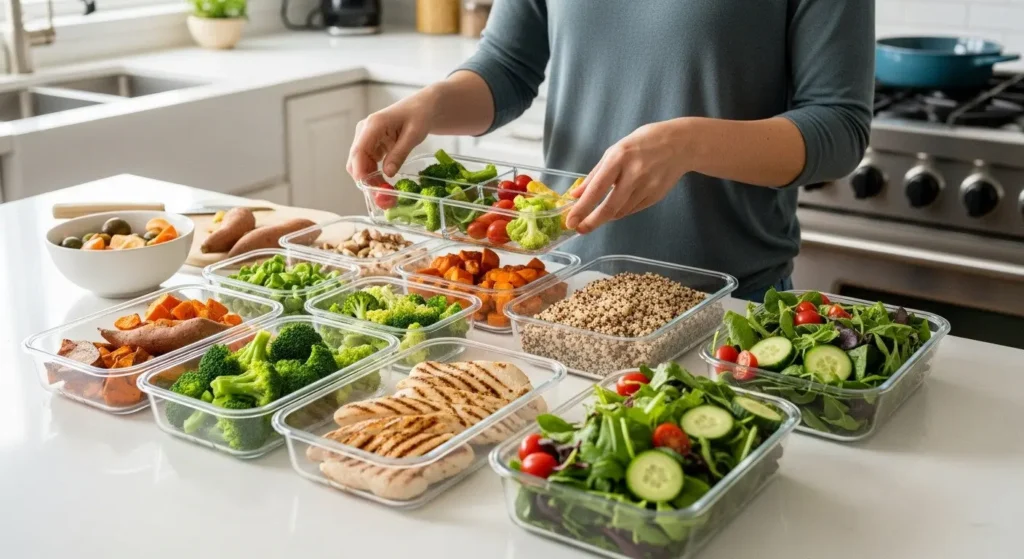
Foods That Combat Belly Fat
- Fatty fish: Rich in omega-3s which may reduce inflammation associated with belly fat
- Probiotic foods: Yogurt, kefir, and fermented foods support gut health, which is linked to lower abdominal fat
- Fiber-rich foods: Especially soluble fiber from oats, beans, and flaxseeds
- Green tea: Contains EGCG which may boost metabolism
- Apple cider vinegar: Some studies suggest it may help reduce belly fat when consumed in moderation
What to Avoid for Belly Fat Reduction
- Sugary beverages (soda, sweetened teas, energy drinks)
- Refined carbohydrates (white bread, pastries, most packaged snacks)
- Trans fats (found in many processed foods)
- Excessive alcohol consumption
Common Mistakes That Sabotage Your Balanced Diet Plan
Even with the best intentions, many people make these common mistakes that hinder their weight loss progress:
1. Overestimating “Healthy” Foods
Avocado, nuts, and olive oil are healthy but calorie-dense. Measure portions rather than eating them freely.
2. Liquid Calories
Smoothies, juices, and specialty coffee drinks can contain hundreds of calories without making you feel full.
3. Skipping Meals
This often leads to overeating later. Aim for regular meals and snacks to maintain stable blood sugar.
4. Not Getting Enough Protein
Protein is crucial for preserving muscle mass during weight loss and keeping you satisfied.
5. Ignoring Hidden Calories
Sauces, dressings, and cooking oils add up quickly. Measure these rather than pouring freely.
6. Being Too Restrictive
Extreme restrictions often lead to indulge eating. Allow yourself occasional treats to maintain balance.
Staying Motivated on Your Weight Loss Journey
Set Realistic Goals
Aim for 1-2 pounds per week, which is sustainable and healthy. The NHS Weight Loss Plan recommends reducing daily calorie intake by 600kcal to achieve this.
Track Non-Scale Victories
Weight isn't the only measure of success. Notice:
- Improved energy levels
- Better sleep
- Clothes fitting better
- Increased strength
- Improved blood work
Build a Support System
Find a weight loss buddy, join a community, or work with a registered dietitian. The Mayo Clinic Diet emphasizes the importance of support for long-term success.
Practice Self-Compassion
Slip-ups happen. What matters is getting back on track with your next meal, not the next day or week.
The Role of Exercise in a Balanced Weight Loss Plan
While diet accounts for about 80% of weight loss, exercise plays a crucial complementary role:
- Cardiovascular exercise: Burns calories during the activity (aim for 150 minutes/week)
- Strength training: Builds muscle which increases your resting metabolic rate (aim for 2x/week)
- Daily movement: NEAT (Non-Exercise Activity Thermogenesis) – taking stairs, walking instead of driving, etc.
The NHS recommends at least 150 minutes of moderate-intensity activity per week for overall health, which also supports weight loss efforts.
Why Most Diets Fail (And How to Avoid This Trap)
Research shows that 95% of people who lose weight regain it within 3-5 years. Why? Most diets focus on short-term restriction rather than sustainable lifestyle changes.
The Mayo Clinic Diet addresses this by having two phases:
- Lose It! – A 2-week jumpstart phase to build healthy habits
- Live It! – A lifelong approach to maintain results
This approach recognizes that weight loss isn't the end goal – maintaining a healthy weight for life is.
Your Balanced Diet Shopping List
Produce
- Leafy greens (spinach, kale)
- Broccoli, cauliflower, Brussels sprouts
- Bell peppers, cucumbers, carrots
- Berries (fresh or frozen)
- Apples, pears, citrus fruits
- Avocados
Proteins
- Chicken breast
- Turkey breast
- Salmon and other fatty fish
- Eggs
- Canned tuna in water
- Lentils, beans, chickpeas
Pantry Staples
- Quinoa, brown rice
- Oats
- Olive oil
- Vinegars (balsamic, apple cider)
- Spices and herbs
- Canned tomatoes (no salt added)
Dairy/Frozen
- Plain Greek yogurt
- Frozen berries and vegetables
- Frozen edamame
Making Your Balanced Diet Budget-Friendly
Eating healthy doesn't have to break the bank:
- Buy seasonal produce
- Purchase frozen fruits and vegetables (just as nutritious)
- Cook in batches to save time and money
- Choose plant-based proteins like beans and lentils more often
- Shop the perimeter of the grocery store where whole foods are located
- Buy in bulk when it makes sense (like oats, quinoa, nuts)
The Mental Shift: From Dieting to Lifestyle
The most important aspect of successful weight loss isn't what you eat on Monday, but what you're still eating five years from now. Shift your mindset from “I'm on a diet” to “I'm building healthy habits.”
As the Mayo Clinic experts state: “The goal is to make simple, pleasurable changes that will result in a healthy weight that you can maintain for the rest of your life.”
Conclusion: Your Balanced Diet for Lifelong Weight Management
Creating a balanced diet for weight loss isn't about deprivation or complicated rules. It's about making sustainable changes that help you feel your best while reaching and maintaining a healthy weight.
Remember these key principles:
- Fill half your plate with vegetables
- Choose lean proteins and healthy fats
- Opt for whole grains over refined carbohydrates
- Practice portion control without obsession
- Stay hydrated and eat mindfully
- Allow for occasional treats to maintain balance
The journey to a healthier weight isn't a sprint but a marathon. By implementing these balanced diet strategies, you're not just losing weight – you're gaining a healthier, more vibrant life that you can enjoy for years to come.
Start today with one small change, and build from there. Your future self will thank you!


